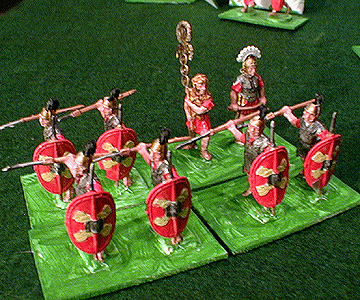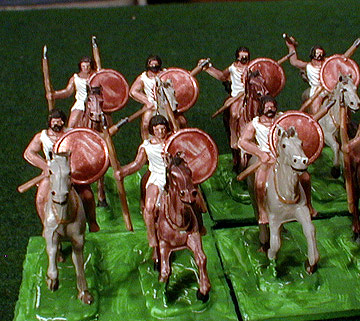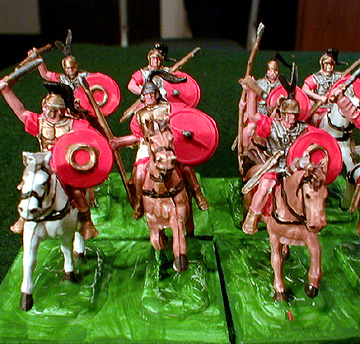
Historical Background
In the second century BC the rich trading empire of Carthage vied with the rising Roman Republic for control of the Mediterranean. In the Second Punic War Carthage's legendary general, Hannibal, surprised the Romans by crossing the Alps and invading their homeland. His army was too tough for the Romans to defeat on the field of battle, but not tough enough to capture Rome. Finally the Romans sent a young and ambitious general named Scipio to invade Carthage. The ploy worked, and Hannibal was summoned home to defend the city.
The decisive battle was fought in Zama, in Northern Africa. The battle featured contrasting armies: the citizen soldiers of the Roman Legions against the mercenary army of Carthage. The two sides were closely matched. The Carthaginian army included close to one hundred poorly trained war elephants. The tuskers were mostly ineffective against the well-prepared Romans. On one flank the Roman cavalry routed the Carthaginian cavalry and pursued them off the battlefield.
In the center the Carthaginians were on the brink of victory when the Roman cavalry suddenly returned and charged them from behind. This unexpected attack led to a rout, and Rome won the battle and the war. Scipio was rewarded with a name change, "Scipio Africanus," and a title, "The Scourge of Carthage." I recreated this battle with my 6th - 8th grade students.
Battle 1
A dozen generals participated in this battle, which was very close until the end. Both sides moved their cavalry behind their infantry, realizing that it would be more valuable later in the battle, when they could turn a flank. The elephants thundered into the Roman line but did little damage. Both sides advanced and engaged. The Romans achieved a breakthrough in the center but the Carthaginians defeated the Roman's left wing. Both sides sent in their cavalry to decide the battle. It was touch and go for a while, but the Romans managed to salvage a narrow victory.
Battle 2
In the second battle General P., "The Scourge of History Club," commanded the Roman left flank. He cleverly goaded the Carthaginian cavalry into charging his infantry while protecting his own cavalry. The well-disciplined Roman Legions crushed the Carthaginians. Then they survived a concentrated assault by the war elephants and suddenly the Carthaginian right flank was wide open. While General B. pinned the center and left flank General P. brought out his cavalry to turn the right flank. General K. sent Hannibal into the fray in a desperate attempt to stop the Romans. Hannibal rallied his African veterans for a last stand but it failed and he was forced to flee for his life. The Romans swept the field, leaving only a defiant General M. to oppose them. This was a decisive Roman victory.
Rules
 The Armies
The Armies
The figures used were 1/72 scale plastics mounted two per stand, a mix from several sets (Italieri and Hat, with Celtic cavalry substituted for the Carthaginian cavalry). Skirmishers were arranged in single rank lines (3-5 stands), formed infantry and cavalry were in double rank lines (6-10 stands). Elephants and Scorpions were single stand units.
The Romans were divided into four infantry commands each containing 2 scorpions, 10 skirmishers, 28 infantry stands, and a General. There were 18 stands of Roman cavalry on the left flank and a cavalry General. The Right flank had 18 stands of Numidian cavalry. One of the Roman Generals was designated as Scipio. The infantry was deployed in lines - velites (skirmishers) in front, followed by three lines of infantry.
The Carthaginians fielded four infantry commands which each included 2 elephants, 5 stands of skirmishers, 8 stands of heavy infantry, 24 stands of light infantry and a General. They also started the battle with 18 stands of Carthaginian cavalry (facing the Roman cavalry), and 6 stands of Numidian Cavalry on the other flank. A cavalry General was included with the Carthaginian cavalry, and two additional elephants were deployed on each flank. One Carthaginian General was designated as Hannibal. The infantry were deployed in lines - elephants in front, followed by skirmishers, then the light infantry, and the heavy infantry in the final line.
The Board
The terrain was flat and a 9 X 6 foot table was used. The armies began about 24 inches apart.
Sequence of Play
1. Roman Move
2. Roman Shoot
3. Carthaginian Move
4. Carthaginian Shoot
5. Charge into Melee
6. Melee
 Movement
Movement
All foot units move 6". Skirmish units may move in any direction. Formed units are limited to wheels and obliques of 45 degrees. Elephants and scorpions also move 6"; cavalry moves 12"
Shooting
Only skirmishers and Numidian cavalry are allowed to shoot. Roll 1D6 for each stand in range. Every 6 is a hit and one enemy stand is removed. If any part of a unit is in range the entire unit may fire. Units that are engaged in melee may not fire, and may not be targeted.
Charge into Melee
Both sides may charge into melee. This is the only way to get into hand-to-hand fighting. Foot units may charge up to 6", cavalry may charge 12". Units may only charge if they can reach an enemy unit.
Melee
Each side rolls 1D6 for each stand in the fight. The Close Combat table shows the number needed to score hits. Remove one enemy stand for every hit. Both sides roll simultaneously. If both units still have stands left they remain engaged and fight again next turn.
Last Stand
If a unit is reduced to one stand this last stand is removed immediately. This rule doesn't apply to elephants and scorpions.
Generals
Generals may not be targeted individually. If they are attached to a unit they count as an extra stand in melee (but not shooting). Scipio and Hannibal each count as two extra stands in melee. If the unit they are attached to loses stands in melee roll 1D6. If the roll is a 6 then the General is eliminated.
Cavalry Flank Attacks
Cavalry units that charge an enemy foot unit on the flank or rear gain an advantage. The foot unit may only fight back with two stands, and the cavalry hits on a roll of 4-6. These advantages apply only on the first turn of melee.
Scorpions
These units may not charge or fight in melee. If an enemy unit charges them they rout and are eliminated.
Elephants
Elephants cannot be eliminated by shooting or in melee. They operate according to their own rules. If they charge a unit of Roman infantry there is a chance that the elephant will be scared away - roll 1D6. If the roll is a 5 or 6 the elephant is removed from the game (it stampedes off the battlefield without causing any damage). Cavalry units do not get a chance to scare away the elephant. Once the elephant hits an enemy unit the victim loses two stands immediately. A die roll is made to see if the elephant remains under control after each round of melee. Roll 1D6 and consult the elephant table. If the roll is a 1 or 2 the elephant remains under control and may continue to fight or move next turn. A roll of 3 - 6 means the elephant goes on a rampage and runs off the battlefield. It immediately makes a double move (12"), passing through any units (friend or foe) in its path. All units contacted lose two stands. After completing this move the elephant is removed from play.
Resources
I drew inspiration from a DBA scenario written by Chris Jones that I found on the Fanaticus web site (http://fanaticus.org/DBA/index.html). A lot of useful information about the Punic Wars can be found in the board game SPQR that is available from GMT Games. I'd also like to thank Chris Tighe for helping me research this battle.
Close Combat : Weapon Hit Number
Romans/Hvy Carthaginians : 5-6
Light Carthaginians : 6
Skirmishers : 6
Roman & Carthaginian Cavalry : 5-6
Numidian Cavalry : 6
Scorpions : 4-6
Any vs. Skirmishers : 4-6
Shooting Table : Weapon Range
Scorpion 24"
Sling/Javelin 6"
Movement
Infantry/Elephants/Scorpions 6"
Cavalry 12"
Elephant Table
Die Roll : Result
1-2 : Remains under control
3 : Rampages 12" straight ahead
4 : Turns right (90 degrees) and rampages 12"
5 : Turns left (90 degrees) and rampages 12"
6 : Turns around (180 degrees) and rampages 12"
Back to SJCW The Volunteer Winter 2001 Table of Contents
Back to SJCW The Volunteer List of Issues
Back to Master Magazine List
© Copyright 2001 by SJCW
This article appears in MagWeb (Magazine Web) on the Internet World Wide Web.
Other military history articles and gaming articles are available at http://www.magweb.com